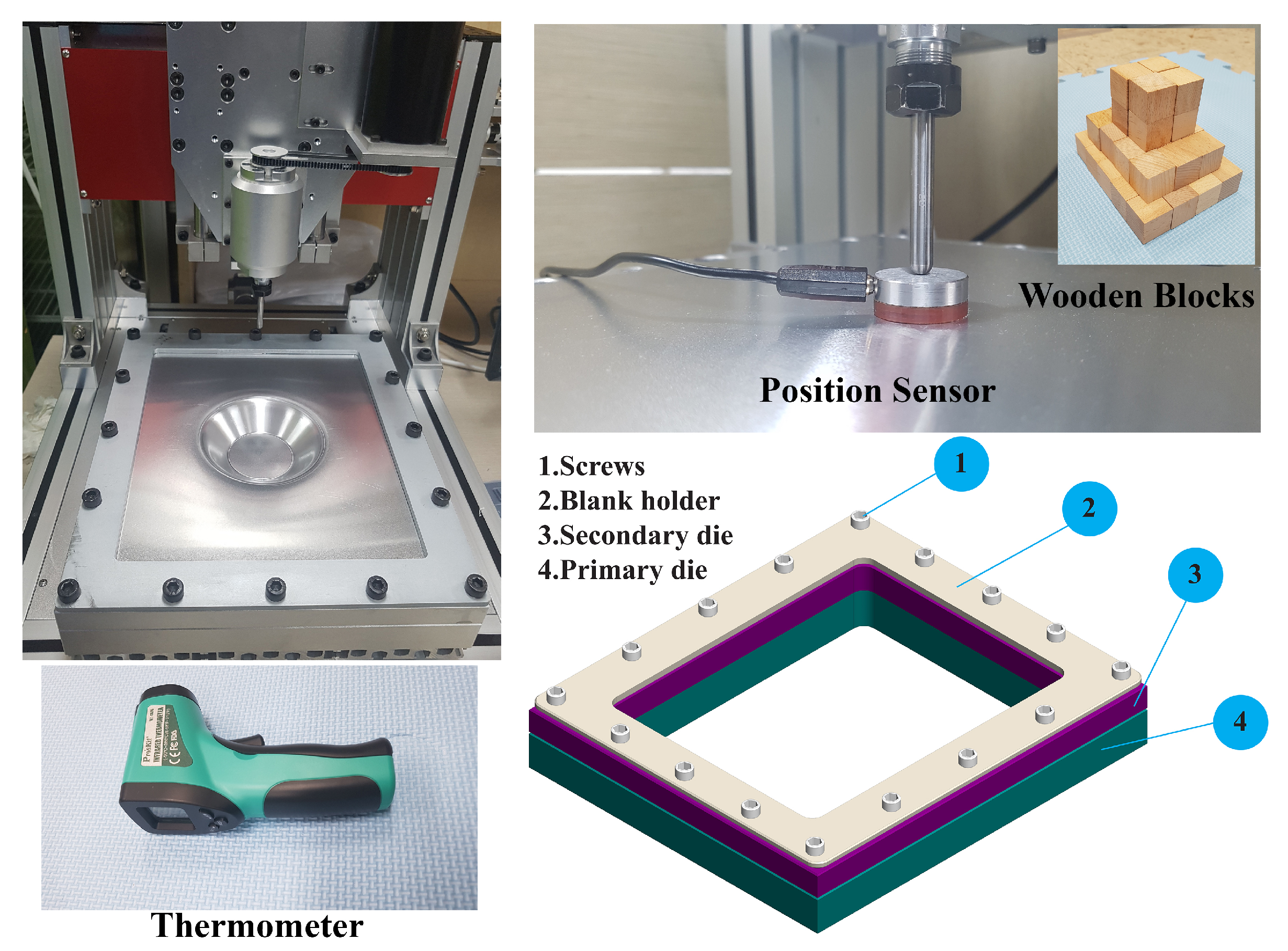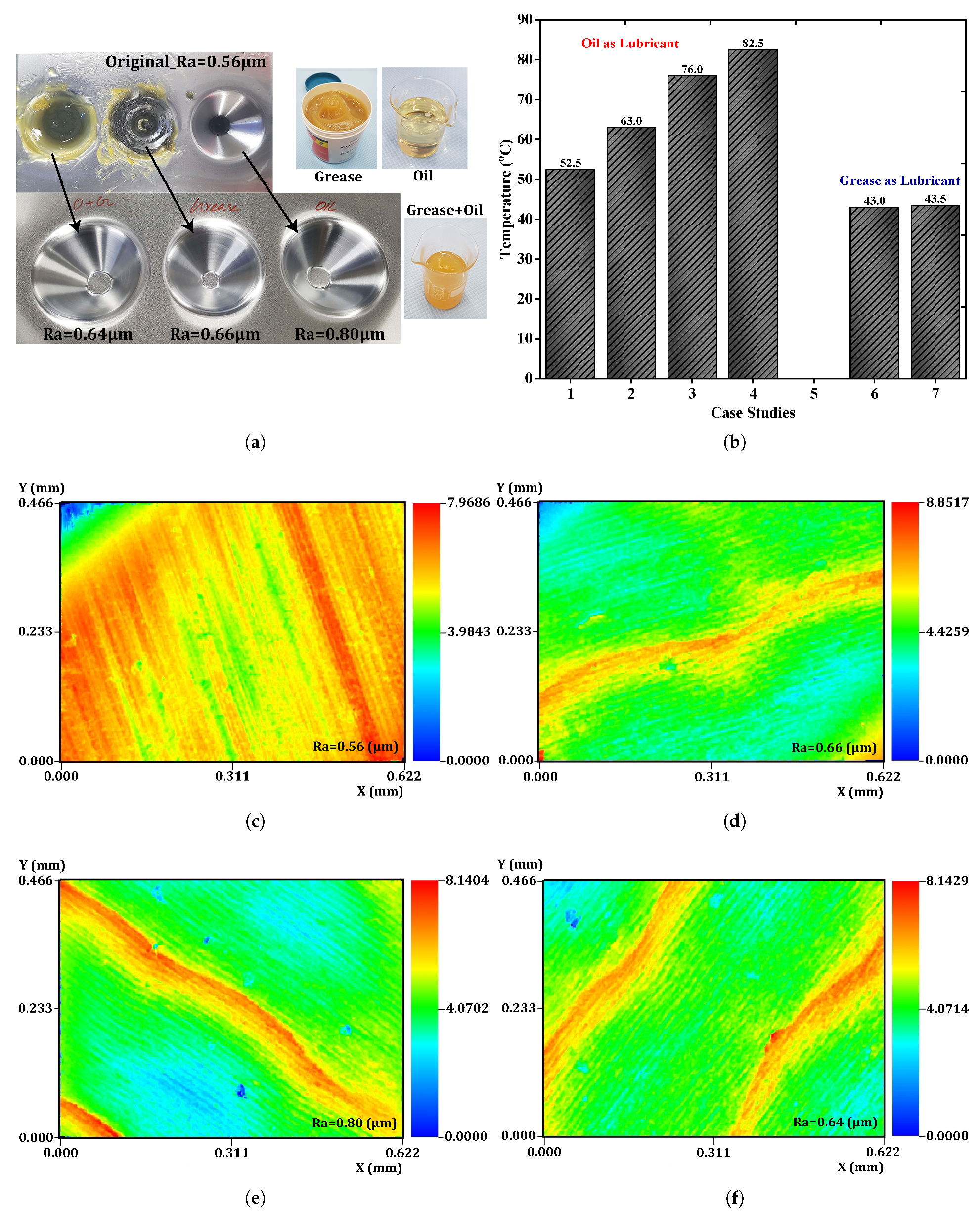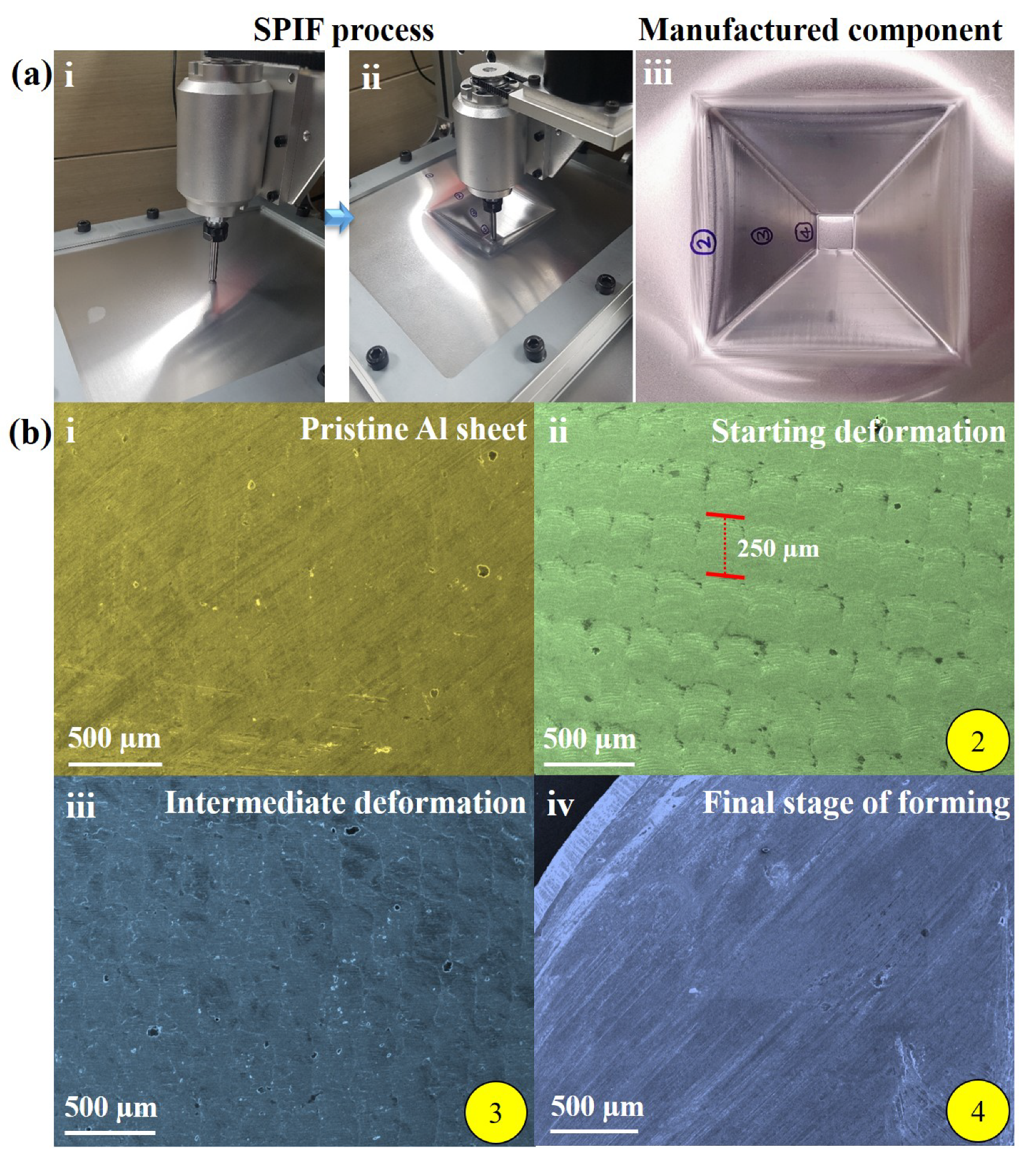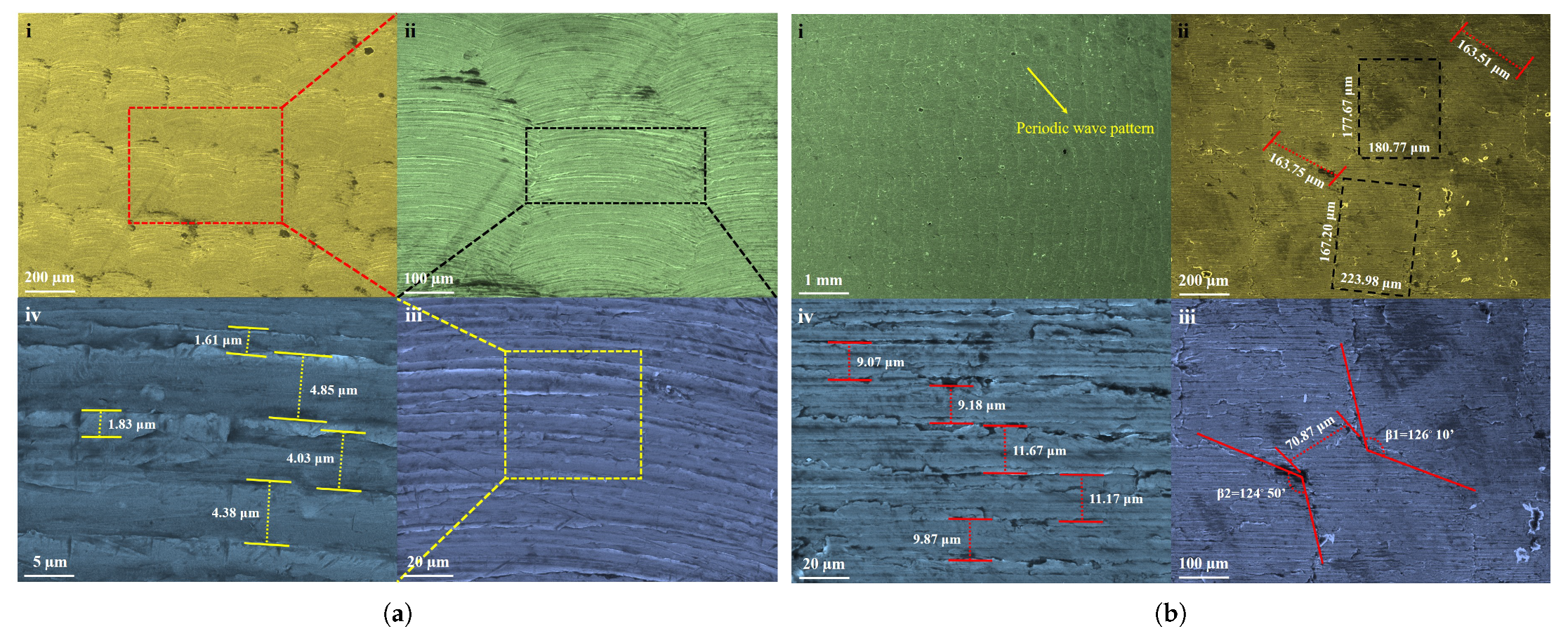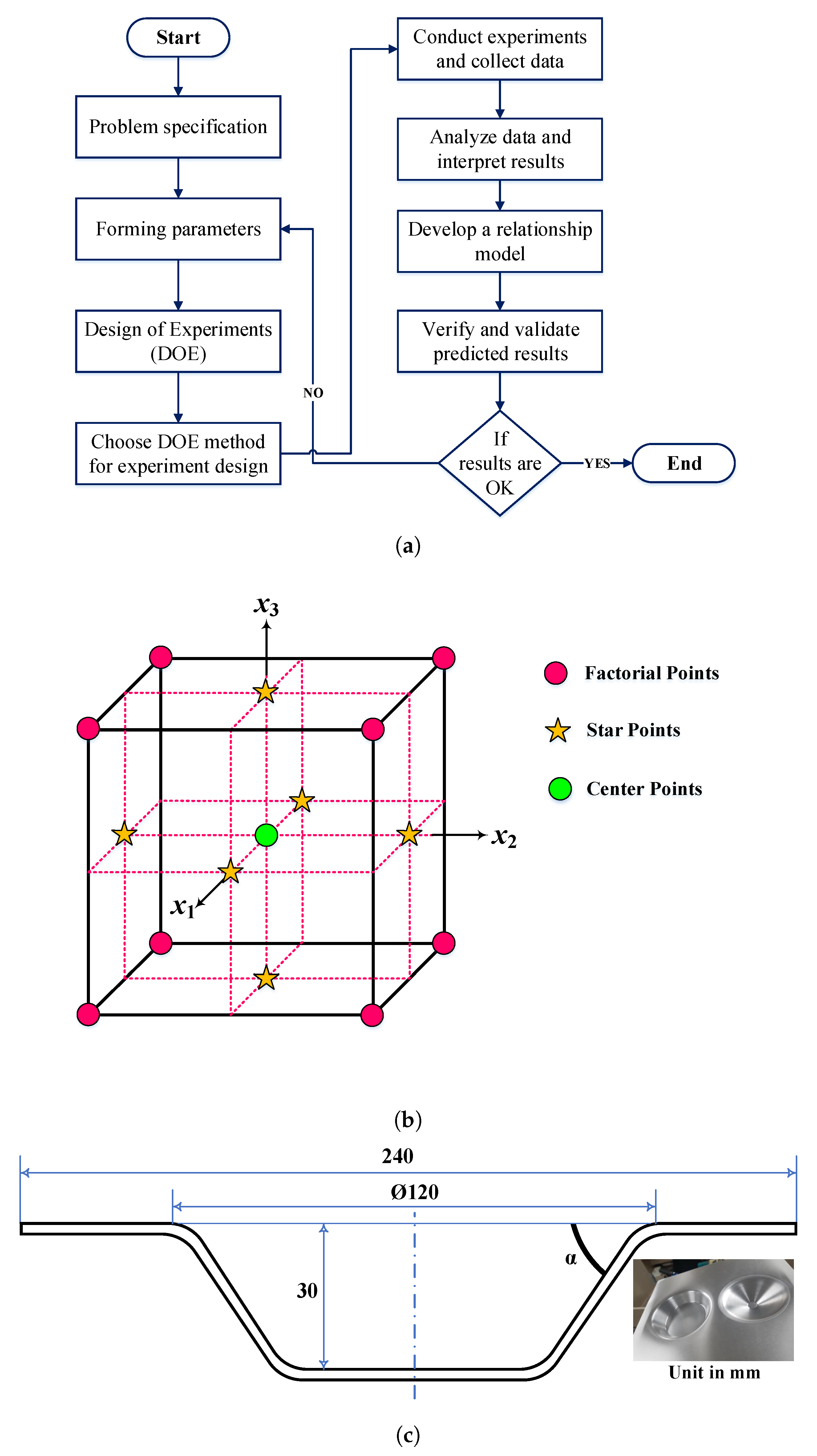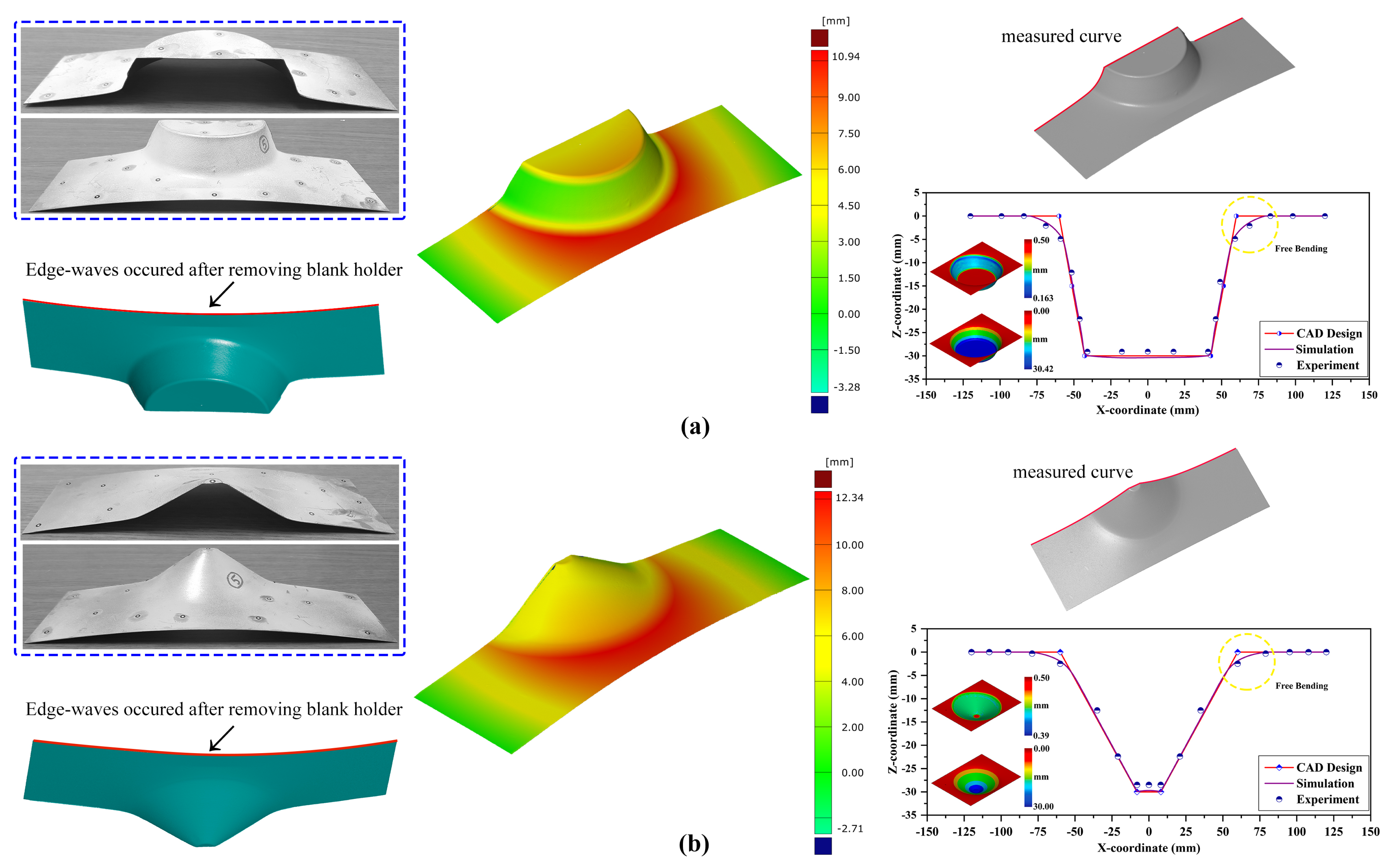4.5. Results and Discussion
This section discusses the surface finish of the incrementally formed parts, the influence of the process parameters on the response variable from ANOVA results, the shape error of the produced parts using 3D scanning, and the microstructure evaluation of the perfectly formed parts and fractured samples using SEM analysis. At first, we aimed to form a part with a 60
outer radius, 30
forming height, and two forming angles (30° and 60°) using the SPIF process, as shown in
Figure 8. For this investigation, the influences of the forming parameters, including tool radius, vertical step–size, and feed–rate, were considered, whereas other parameters like sheet thickness, tool shape, and lubricant remained constant. As an example, an incrementally formed part at the end of the forming process is depicted in
Figure 8; the magnified views are provided to show the part’s surface finish. The magnified pictures show that the forming tool’s contour path can be noticed with the 30° truncated cone shape compared to the 60° cone shape. Edge waviness is noticed on the formed sheet at the fixture location, which occurred due to material flexibility and sheet fluctuations during the continuous incremental forming process. In detail, the fluctuations occurred during the forming process because the incremental forming process intends to form a material sheet gradually and locally by applying the punch force at a specified location; as the process continues based on the predefined tool path, the fluctuations tend to occur throughout the entire process. However, close to the support, as highlighted in
Figure 8, this edge waviness was not witnessed due to the strong bending at that location.
The desired 3D CAD models were compared against the scanned models to check for the presence of deviations, as depicted in
Figure 9. As shown in
Figure 9a,b, the formed parts tended to have an extra backward bending at the fixture location in both forming angle cases. Apart from the test results, the 3D scanned contour shows that deviations were identified as
for 60° and
for 30° truncated conical geometries. The slightest error may have occurred in the scanned model data due to the reference point alignment during model comparison. However, the data were cross-verified by manual measurement, and the computed shape deviation was confirmed to be close to the manual estimation. For evaluating the accuracy of the formed part, the finite element model was modeled, and the mechanical properties achieved from the tensile test were incorporated into the material card, MAT18, which can consider the power law of plasticity for describing the material’s plastic behavior. The FEM accuracy was controlled with a reasonable number of elements in the blank material and was considered to be deformable; the forming tool was meshed with coarse elements and considered to be rigid. Due to the lubrication selection, a combination of oil and grease, the friction coefficient was assumed to be almost close to zero. To reduce the computation time, the blank sheet mesh was considered to be a shell element with five integration points, whereas the punch tool was also assumed to be a shell element with the same number of integration points. As shown in
Figure 9a,b, the cross-section coordinates were compared among the CAD data, test data, and numerical simulation data. We confirmed that the models had free edge bending close to the start of the forming location, as magnified in the comparison plots, due to lack of extra support at the location and the material adaptability to punch force. The free bending can be observed in detail in the scanned contours (
Figure 9a,b, red color regions close to initial forming location). The same procedures were followed for the other tested samples, and the data of final thickness, forming height, forming angle, and average surface roughness were collected for performing the statistical analysis to build a regression model of grey relational grade.
The multilinear regression model with linear, square, and interaction effects was chosen for developing the prediction model of GRG values using
Table 8. The obtained prediction model with the model coefficients is presented in Equation (9). The achieved regression model was further numerically validated. Statistical metrics for verification were assessed and are compiled in
Table 9. The prediction model’s capability in
was computed as 0.8931, indicating that the fitted regression model adequately aligned with the estimated GRG data. An
value of 0.8931 indicated that the input parameter’s variance explained 89.31% of the response variable’s variance. As shown in
Table 9, the adjusted–RSQ values were quite close to
, but slightly less, typically occurring as the number of input factors increases. Other statistical parameters, such as RMSE and AARE, were estimated as 0.0196 and 2.78%, respectively, proving the overall closeness of the proposed regression model to the measured data. Apart from the numerical metrics, graphical verification was performed, as shown in
Figure 10a,b. The relationship plot (
Figure 10a) provides visual information about how the predicted data were distributed around the best fit line; we clearly observed that the predicted samples laid very close to the fitted regression line. The residual plot was constructed based on the differences between the measured and predicted data, as illustrated in
Figure 10b.
Figure 10b shows that the residual population followed the random pattern, which proved the usefulness of the proposed empirical model; the residual data fell close to the zero error line, except for a few outliers. However, the error range was identified to be between −0.05 and 0.05, which is p significantly lower. The histogram plot of the residuals was constructed (
Figure 10b, inset image) and we found that the residual data were distributed normally in the design space with variance and mean of 3.3748 and −0.1232, respectively.
Analysis of variance (ANOVA) results for the proposed prediction model are listed in
Table 9. The proposed model F-value was found to be 4.64 (GRG), indicating that the developed model is statistically significant overall in terms of the process parameters: feed rate, vertical step-size, and tool radius. A
p-value less than 0.05 indicates the importance of the forming parameters that influence the response variable (the grey relational grade.) The model terms
(0.020),
(0.018), and
(0.026) were found to be significant as they had
p-values less than 0.05, while the other terms were found to be insignificant. Besides the
p-value, another statistical parameter, the F-value, was found to be 11.30 (
), 12.16 (
), and 9.72 (
), showing the importance of the computed model terms. The proposed model contributed 89.29% to capturing the response variable in the design space, while the model error was computed to be 10.7%. In detail, the model terms
,
,
, and
contributed 24.18%, 26.02%, 10.50%, and 20.80%, respectively, more than the other model terms.
To examine the influence of the input parameters on the response, the average response of each level input factor is calculated and plotted using the line graph. If the estimated data points form a horizontal line, then there is no main effect. Conversely, if the plotted data points represent positive or negative deflection to the horizontal line, then the main effect is presented in the regression model [
48]. To investigate the main effect of the input factors on the grey relational grade, the graphical illustration of the proposed regression model, i.e., 2D line plot, was used, as shown in
Figure 11a, and the computed GRG values are presented in
Table 10.
Figure 11a depicts that the model terms
(tool radius) and
(step–size) provided a combination of positive and negative responses on the output variable. In detail, the GRG value increased with the tool radius,
, up to
, and then decreased to
; similarly, it increased linearly with the step size,
, up to
, and then dropped to
. However, the model term
(feed rate) showed an entirely positive response and was identified as the most significant parameter, whereas the model term
(step size) was chosen as the second most important parameter that influenced the response.
Table 10 provides the ranking information about the input parameter’s influences on the response.
The interaction plots are used here to represent how the relationship between one process parameter and a response variable, the mean GRG value, depends on the second process parameter value. The computed GRG values are summarized in
Table 11. For example,
Figure 11b displays the mean GRG for the levels of one process parameter on the
x-axis and a separate line for each level of another process parameter. The plotted lines in
Figure 11b were evaluated in detail to explain and understand how the interactions affect the relationship between the input factors and the response (mean GRG value). The plotted lines can be interpreted using two options: parallel lines, which mean there is no interaction between input factors and response; and nonparallel lines, in which an interaction occurs among the input factors and response. For example, if more nonparallel lines are identified, then the interaction strength is more significant. In this interaction plot (
Figure 11b), the lines are not parallel for the model terms
and
. This interaction effect indicated that the relationship between step size and mean GRG value depended on the tool radius value. For example, if a step–size of
is considered, a tool radius of
is associated with the highest mean GRG value. Conversely, in
Figure 11b, the lines are almost parallel for the model terms
,
, and
, indicating no relationship among them on the response variable. As the interaction effects were significant in the model term
, the main effects cannot be interpreted without acknowledging the interaction effects of the
and
factors. Even though the plots represent the interaction effect, other statistical parameters in the ANOVA test have to be evaluated to confirm the effect’s statistical significance. From the ANOVA results in
Table 9, the developed regression model’s F-value, and
p-value of interaction term
are 9.72 (GRG) and 0.026 (GRG) (<0.05), respectively, showing that the interaction effect of
on the mean GRG value is statistically significant.
Model reduction is one of the regression model strategies that allow the user to simplify a developed regression model by omitting insignificant model terms using ANOVA results. The advantage of model reduction is that terms reduction can make the model easier to working with; notably, sometimes, omitting insignificant terms can decrease model accuracy. In this work, Equation (9) was reduced by manually eliminating insignificant model terms (
p-value > 0.05), and the remaining model terms (
p–value < 0.05 and 0.10 [
49]) were used to build a new regression model. The reduced model is presented in Equation (10). From Equation (10) and
Table 12, the model terms are perceived to be statistically significant based on each coefficient’s
p-value; however, the statistical parameters
, adjusted–
, and RMSE showed trivial results in terms of model prediction. Besides, the proposed model was observed to be insignificant through graphical verification, such as residual and histogram plots, as the residuals were distributed randomly with too many outliers, as shown in
Figure 10c. Eventually, the response optimizer tool was used to identify the combination of input factor settings that optimize the response (GRG value). From the optimizer, the optimal solution of the response variable, a GRG value of 0.7081, was identified using the optimum forming parameters:
tool radius,
vertical step size, and 3000
/
feed rate.
From
Figure 12a, the sample’s distribution shows that these observations were obtained from a three-level design and shows linearity. However, it reveals that the deviations occurred in the model prediction for the tested input points due to the presence of outliers; the data deviations at each level follow vertical data distribution. To represent the proposed regression model’s usefulness, the measured data, GRG values, were compared against the predicted data between the full and reduced empirical models, as shown in
Figure 12b. The observation revealed that the predicted data fell close to the measured data (GRG values) for most observations. The reduced regression model displayed a considerable deviation in the prediction response. Overall, the statistical approach exhibited here can be used to predict the GRG values or any selected single objective for the preferred material to produce parts with better formability, surface finish, and faster machining time by thoroughly reviewing the process parameters.
The incrementally produced part’s external surface (tool contact region) using a lubrricant combining oil and grease was examined using FESEM pictures, as depicted in
Figure 13a.
Figure 13a, depicting the magnified scanning electron microscope (SEM) images at 20, 50, and 100
, shows that the surface tended to have a uniform deformation during the forming process; because of this observation, the smooth transition between the forming tool and the blank was presumed.
Figure 13b,c illustrates the scanned surfaces of the formed samples from the fourth experimental design;
Table 3 and
Table 4 provide results at magnification levels of 10, 20, 50, and 100
.
Figure 13b shows the apparent association of forming paths due to the punch tool movement along the blank with the predefined vertical step size for 60° truncated conical shape geometry. As the magnification levels increased (
Figure 13b), at 10 and 20
, the insets show that a uniform region was observed to have irregular micro-cracks between the forming path lines. This response occurred due to the thinning that occurs during the forming process; if more thinning occurs, it might lead to a fracture in the test sample. Similarly, in
Figure 13c, the same kind of consistent homogeneous deformation response is observed in the scanned surface at 100
by identifying forming paths. However, the scanned surface tended to have more irregular micro-cracks all over the surface, and the vertical step size was usually responsible for these micro-cracks observations. The insets in
Figure 13c depict the scanned surface’s amplified images at 10 and 20
; from the inset images, micro-cracks can be seen more clearly. Notably, the formed part did not have any visual cracks; the cracks were only observed in FESEM photographs. However, the fractured sample from thinning failure occurrence was cut down for examining the outer (tool contact region) surface. The magnification of a fractured surface at the 100
scale is depicted in
Figure 13d. The SEM pictures of a fractured surface at higher magnifications in various regions are illustrated in
Figure 13d (insets); the insets show that the fracture was predominantly ductile. As shown in the insets in
Figure 13d at the 50 and 100
scales, the damage concentrated due to nucleation, then slowly evolved as voids coalesced, and propagated into near regions as secondary voids coalescence. This continuous nucleation of tiny voids coalescence led to the fracture during the forming process. In conclusion, FESEM investigations are useful for understanding and observing the deformation mechanisms behind the SPIF process.

